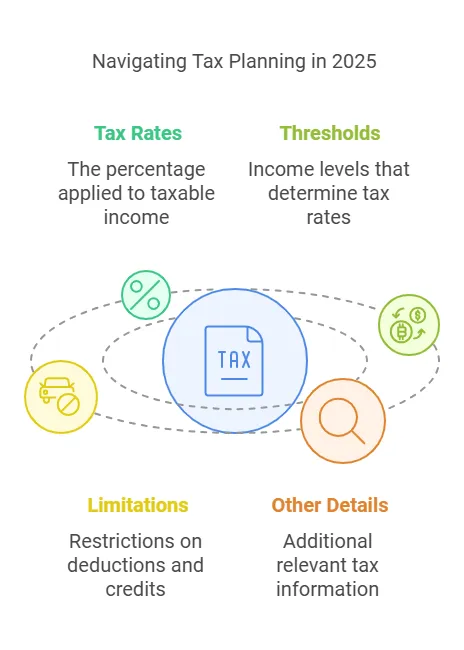
Key Financial Data 2025
Here's a summary of the tax changes from 2024 to 2025:
Tax Rates and Brackets:
Tax brackets and tax rates are increased for 2025 to account for inflation.
The IRS increased tax brackets by about 2.8% for each type of tax filer for 2025. This is less than the 7% increase in 2023 and the 5.4% increase in 2024.
More income may fall into lower tax brackets due to these adjustments. For example, for single filers in 2025, the first $11,925 of taxable income is taxed at 10%, compared to $11,600 in 2024.
There are still seven federal income tax rates: 10%, 12%, 22%, 24%, 32%, 35%, and 37%.
Standard Deduction:
The standard deduction is increased for 2025.
For married couples filing jointly, the standard deduction is $30,000 in 2025, up from $29,200 in 2024.
For single filers and those married filing separately, the standard deduction is $15,000 in 2025, up from $14,600 in 2024.
For heads of household, the standard deduction is $22,500 in 2025, up from $21,900 in 2024.
Additional Standard Deductions:
The additional standard deduction for those who are blind or over 65 is $1,600, up from $1,550 in 2024.
The additional deduction for unmarried taxpayers who are blind or over 65 is $2,000, up from $1,950 in 2024.
Alternative Minimum Tax (AMT):
AMT exemption amounts have increased for 2025. For example, for married couples filing jointly, the exemption rises to $137,000, up from $133,300 in 2024.
Gift and Estate Tax:
The estate, gift, and generation-skipping transfer (GST) exclusions rise to $13,990,000 in 2025 from $13,610,000 in 2024.
The annual gift tax exclusion increases to $19,000 in 2025 from $18,000 in 2024.
Retirement Plans:
The total amount that employers and employees can contribute to a 401(k) or similar defined-contribution plan rises to $70,000 in 2025, up from $69,000 in 2024.
The maximum annual employee contribution to a 401(k) increases to $23,500 in 2025 from $23,000 in 2024.
Individuals between 60 and 63 can make a larger catch-up contribution of $11,250.
The limit on compensation that can be counted under a qualified plan increased to $350,000 from $340,000 in 2024.
The basic annual benefit limit for defined-benefit plans increased to $280,000 from $275,000 in 2024.
New parents can withdraw up to $5,000 each from their retirement account without penalty.
Income thresholds for deductible IRA contributions are slightly higher in 2025 due to inflation.
The annual limit for tax-free IRA distributions to charity (QCDs) increases to $108,000, up from $105,000 in 2024.
Health Savings Accounts (HSAs):
The minimum annual deductible for a qualifying health plan is $1,650 for an individual plan (up from $1,600 in 2024) and $3,300 for family coverage (up from $3,200 in 2024).
The maximum deductible contribution to an HSA in 2025 is $4,300 for individuals and $8,550 for family coverage.
Medicare:
Medicare premium surcharges for high-income retirees may increase due to inflation adjustments.
The standard Medicare premium in 2025 is $185.00.
Social Security:
Social Security beneficiaries are set to receive a 2.5% cost-of-living adjustment (COLA) to their benefits in 2025.
The estimated maximum monthly benefit is $4,018 in 2025, up from $3,822 in 2024.
The maximum taxable wage base is $176,100 in 2025, up from $168,600 in 2024.
The earnings threshold for a reduction in benefits for people younger than their full retirement age is $23,400 in 2025, up from $22,320 in 2024.
In the year a beneficiary reaches full retirement age, $1 of benefits is withheld for every $3 of earnings above $62,160 in 2025, up from $59,520 in 2024.
Other Notable Changes:
The deduction for long-term care premiums has decreased slightly for 2025.
The phaseouts for the 20% deduction against qualified business income (QBI) for pass-through entities and business owners who file a Schedule C are increased to $394,600 for married filing jointly (or $197,300 for single).
